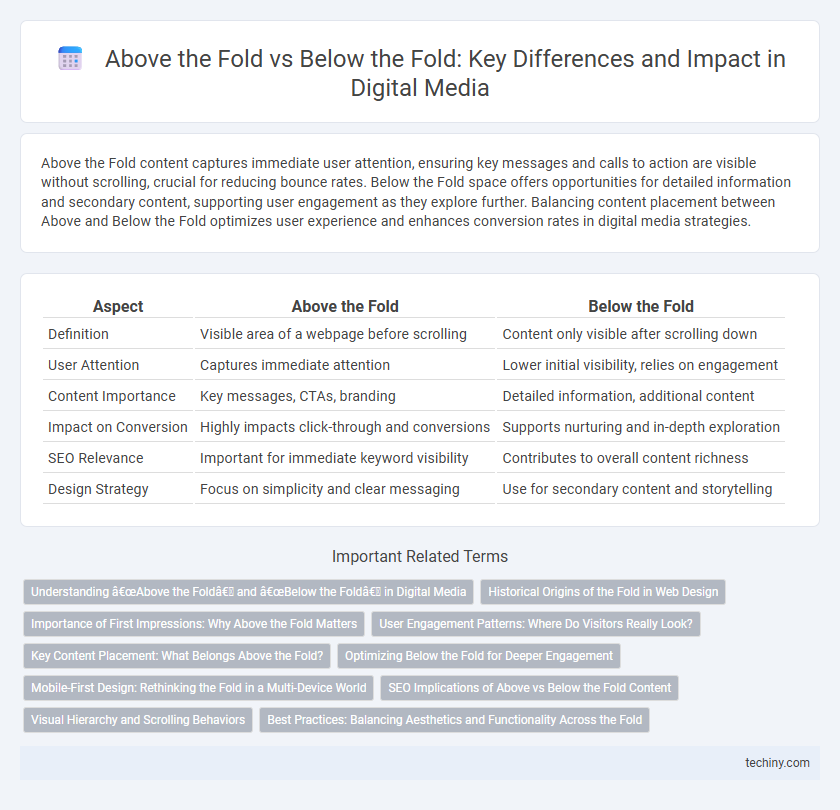Above the Fold content captures immediate user attention, ensuring key messages and calls to action are visible without scrolling, crucial for reducing bounce rates. Below the Fold space offers opportunities for detailed information and secondary content, supporting user engagement as they explore further. Balancing content placement between Above and Below the Fold optimizes user experience and enhances conversion rates in digital media strategies.
Table of Comparison
| Aspect | Above the Fold | Below the Fold |
|---|---|---|
| Definition | Visible area of a webpage before scrolling | Content only visible after scrolling down |
| User Attention | Captures immediate attention | Lower initial visibility, relies on engagement |
| Content Importance | Key messages, CTAs, branding | Detailed information, additional content |
| Impact on Conversion | Highly impacts click-through and conversions | Supports nurturing and in-depth exploration |
| SEO Relevance | Important for immediate keyword visibility | Contributes to overall content richness |
| Design Strategy | Focus on simplicity and clear messaging | Use for secondary content and storytelling |
Understanding “Above the Fold” and “Below the Fold” in Digital Media
"Above the fold" in digital media refers to the portion of a webpage visible without scrolling, crucial for capturing users' attention and driving engagement. Content placed above the fold typically experiences higher click-through rates and faster user interaction due to immediate visibility on various screen sizes and devices. Conversely, "below the fold" content requires scrolling, often serving secondary information or deeper engagement elements, impacting overall user experience and conversion rates in digital marketing strategies.
Historical Origins of the Fold in Web Design
The concept of "above the fold" in web design originates from traditional print newspapers, where the upper half of the front page visible when folded was considered prime real estate for important headlines. Early web designers adapted this principle to prioritize content that appears immediately without scrolling, aiming to capture user attention quickly in limited screen space. Over time, evolving screen sizes and user behaviors have shifted the importance of the fold, yet its historical impact on layout hierarchy remains a foundational element in digital media design strategy.
Importance of First Impressions: Why Above the Fold Matters
Above the fold content captures visitors' attention instantly, significantly influencing engagement and reducing bounce rates on digital platforms. Studies show that over 80% of user interactions occur within the first few seconds of landing on a webpage, emphasizing the need for strategic placement of key messages and call-to-actions above the fold. Prioritizing above the fold elements enhances user experience and drives higher conversion rates by making critical information immediately visible.
User Engagement Patterns: Where Do Visitors Really Look?
User engagement patterns reveal that digital audiences primarily focus on Above the Fold content, with approximately 80% of attention captured within this initial visible screen area. Below the Fold sections experience sharply reduced engagement, often receiving less than 20% of visitor interaction, highlighting the critical need for strategic placement of key information above the fold. Optimizing content layout to prioritize Above the Fold elements enhances user retention and drives higher conversion rates in digital media campaigns.
Key Content Placement: What Belongs Above the Fold?
Key content placement above the fold in digital media includes critical information such as headlines, primary calls to action, and engaging visuals that capture user attention immediately. Ensuring that essential elements like navigation menus and value propositions are visible without scrolling improves user experience and conversion rates. Prioritizing above the fold content increases engagement by delivering key messages promptly on various devices and screen sizes.
Optimizing Below the Fold for Deeper Engagement
Optimizing below the fold content enhances user engagement by delivering valuable information that encourages deeper site exploration and longer visit durations. Employing dynamic elements such as interactive features, compelling visuals, and targeted calls-to-action below the fold increases scroll depth and conversion rates. Effective below the fold strategies complement above the fold design by sustaining user interest and driving meaningful interactions in digital media campaigns.
Mobile-First Design: Rethinking the Fold in a Multi-Device World
Mobile-first design challenges the traditional concept of "above the fold" by emphasizing content prioritization tailored to diverse screen sizes and orientations. User engagement on smartphones and tablets depends on dynamic, scroll-friendly layouts that ensure critical information is immediately visible without compromising accessibility below the fold. Responsive frameworks and fluid grids optimize digital media experiences across devices, enhancing usability and retention through strategic visual hierarchy beyond fixed fold boundaries.
SEO Implications of Above vs Below the Fold Content
Above the fold content plays a critical role in SEO by immediately capturing user attention and signaling relevance to search engines, which prioritize visible content for ranking. Content placed below the fold may receive less engagement and perceived importance by crawlers, potentially diminishing its impact on SEO performance. Optimizing key keywords, calls to action, and valuable information above the fold increases both user interaction and search engine visibility, enhancing overall digital media effectiveness.
Visual Hierarchy and Scrolling Behaviors
Above the fold content captures user attention immediately, leveraging visual hierarchy through prominent headlines, vibrant images, and concise calls-to-action that align with natural scrolling behaviors. Below the fold requires strategic design elements, such as clear section divisions and progressive content reveal, to maintain engagement as users scroll deeper. Understanding these dynamics optimizes layout effectiveness and improves user interaction metrics in digital media platforms.
Best Practices: Balancing Aesthetics and Functionality Across the Fold
Effective digital media design requires balancing aesthetics and functionality both above and below the fold to optimize user experience and engagement. Above the fold, prioritize clear calls-to-action and essential information to capture immediate attention, while below the fold should seamlessly support deeper content exploration and interaction without overwhelming the user. Strategic content placement, responsive design, and performance optimization ensure that critical elements remain accessible across diverse devices and screen sizes, enhancing overall site usability and conversion rates.
Above the Fold vs Below the Fold Infographic

 techiny.com
techiny.com